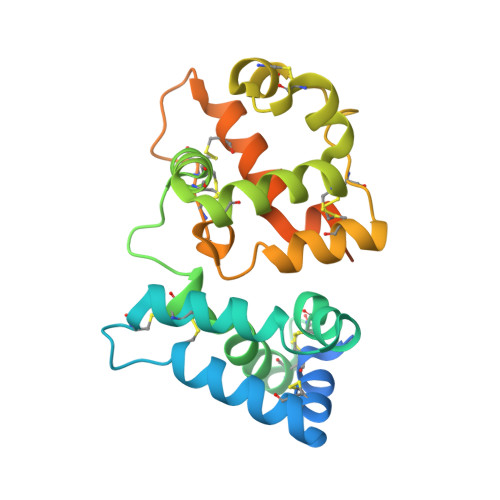Non-homeostatic body weight regulation through a brainstem-restricted receptor for GDF15.
Hsu, J.Y., Crawley, S., Chen, M., Ayupova, D.A., Lindhout, D.A., Higbee, J., Kutach, A., Joo, W., Gao, Z., Fu, D., To, C., Mondal, K., Li, B., Kekatpure, A., Wang, M., Laird, T., Horner, G., Chan, J., McEntee, M., Lopez, M., Lakshminarasimhan, D., White, A., Wang, S.P., Yao, J., Yie, J., Matern, H., Solloway, M., Haldankar, R., Parsons, T., Tang, J., Shen, W.D., Alice Chen, Y., Tian, H., Allan, B.B.(2017) Nature 550: 255-259
- PubMed: 28953886
- DOI: https://doi.org/10.1038/nature24042
- Primary Citation of Related Structures:
5VZ3, 5VZ4 - PubMed Abstract:
Under homeostatic conditions, animals use well-defined hypothalamic neural circuits to help maintain stable body weight, by integrating metabolic and hormonal signals from the periphery to balance food consumption and energy expenditure. In stressed or disease conditions, however, animals use alternative neuronal pathways to adapt to the metabolic challenges of altered energy demand. Recent studies have identified brain areas outside the hypothalamus that are activated under these 'non-homeostatic' conditions, but the molecular nature of the peripheral signals and brain-localized receptors that activate these circuits remains elusive. Here we identify glial cell-derived neurotrophic factor (GDNF) receptor alpha-like (GFRAL) as a brainstem-restricted receptor for growth and differentiation factor 15 (GDF15). GDF15 regulates food intake, energy expenditure and body weight in response to metabolic and toxin-induced stresses; we show that Gfral knockout mice are hyperphagic under stressed conditions and are resistant to chemotherapy-induced anorexia and body weight loss. GDF15 activates GFRAL-expressing neurons localized exclusively in the area postrema and nucleus tractus solitarius of the mouse brainstem. It then triggers the activation of neurons localized within the parabrachial nucleus and central amygdala, which constitute part of the 'emergency circuit' that shapes feeding responses to stressful conditions. GDF15 levels increase in response to tissue stress and injury, and elevated levels are associated with body weight loss in numerous chronic human diseases. By isolating GFRAL as the receptor for GDF15-induced anorexia and weight loss, we identify a mechanistic basis for the non-homeostatic regulation of neural circuitry by a peripheral signal associated with tissue damage and stress. These findings provide opportunities to develop therapeutic agents for the treatment of disorders with altered energy demand.
- NGM Biopharmaceuticals, South San Francisco, California 94080, USA.
Organizational Affiliation:




















